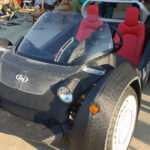Siemens recently announced a new automotive project in collaboration with Hackrod. Both companies are looking to leverage a host of modern technologies including hybrid manufacturing, AI and VR into the automotive field with a project they have dubbed ‘La Bandita’. The project will present an entirely new approach, looking to upend traditional car manufacturing and conceptualisation by empowering customer-led design.
The project is actually between Siemens’ PLM software company and Hackrod, who specialize in producing hotrod/speedsters. Hackrod’s CTO Slade Gardner and CEO/former Hollywood stunt driver Mike Mccoy presented their project at the Siemens Industry Analyst Conference 2018. Hackrod is using Siemens MindSphere as the AI infrastructure for the custom AM process Gardner and his team developed. The project also integrates Siemens’ NX software, cloud-based Solid Edge Portal software, Sinumerik CNC control software and LMS Testing Solutions.
The design of the machine also has much to owe to the proprietary dual deposition and CNC machining platform. This hybrid printer gives them far more control over the entire process, utilising the best in software and hardware. The process works like this: First, the additive head extrudes material and then moves out of the way as the 5-axis spindle CNC’s the excess material away using 10-position tool changes.
It can use a ball mill, a lollipop cutter, block cutter or even an end mill. This versatility gives it the freedom to create the specifics of the exact geometric design. The build volume for its aluminum wire arc AM is 12 feet x 6 feet x 4 feet, which is fairly large for metal 3D printing.
Hotrods for the 21st Century
The company describes itself:
“Hackrod is a clean sheet industry 4.0 company redefining the way vehicles are designed, engineered and produced in the 21st Century. Hackrod draws from the artistry and individuality of 20th century ‘Hotrodding’ and the rebellious, tech savvy innovation of ‘hacker’ culture to empower the everyman to create the vehicle of his dreams or needs.”
The company originally built cars from reclaimed parts and began outfitting them with off-the-shelf sensors. Hackrod trialled these cars by putting them under stress tests in different driving situations. The data they collected proved both interesting and useful. While it may seem odd, data-driven approaches to manufacturing are rare in the wider automotive industry. Often, companies rely on conventional knowledge and standards. Hackrod is taking the approach typically associated with software firms and applying it to the automotive industry.
The company is also massively benefitting from Siemens’ work with hardware connectivity along with multi-axis additive manufacturing. The manufacturing process allows the customer to visualise and design the car of their choice. The company then manufactures it and inspects for compliance with high standards and racing regulations.
Mindspace, Machine Learning & Manufacturing
Hackrod’s use of MindSphere for simulating the development process enables many advantages. They begin the process by putting an initial digital chassis through a machine learning simulation, allowing Hackrod to successfully digitize the external sensor-to-chassis environment. By pairing up a machine learning simulation within the available design parameters of its proprietary multi-axis AM process, Hackrod is able to optimize the chassis design for a faster manufacturing flow than those that characterise most industrial AM operations.
Hackrod also uses VR to review the designs of the La Banditas and other cars. They have workstations where they use NX Virtual Reality and HTC Vive technology to simulate the automotive functions. These are far quicker and more comprehensive than the industry standard clay models. They can further adjust all of the necessary changes more easily in digital form. NX also allows them to incroporate Convergent Modeling and topology optimization where need be.
The project is still far away and requires a lot of work to go. It’s a fascinating endeavour that will keep improving. In fact, for Hackrod, there’s one final step post-printing. They use Siemens LMS Testing Solutions to perform a final comparison between the virtual product design and the manufactured physical version. This step allows them to compare how their data stacks up with reality, ensuring subsequent models will be even better.
Featured images courtesy of Hackrod.












